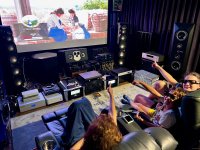|
|
馬上註冊,結交更多好友,享用更多功能,讓你輕鬆玩轉社區。
您需要 登錄 才可以下載或查看,沒有賬號?註冊
x
How 3D Works
Blu-ray 3D in the Home
Authoring Blu-ray 3D
How 3D Works
The Basics of Stereoscopic Imaging
3D is based on the principle of stereoscopy, which creates the illusion of depth in an image. The easiest way to enhance depth perception in the brain is to provide the eyes of the viewer with two different images, representing two perspectives of the same object, with a minor deviation exactly equal to the perspectives that both eyes naturally receive in binocular vision.
Put in simpler terms, 3D is stereo for your eyes. To achieve this, you need two images that are offset approximately the same distance as the average spacing between human eyes – about four inches. This is often achieved by shooting video with two cameras, or a special camera with two lenses. There are also post-production techniques that can add depth-mapping to 2D imagery to create a stereoscopic effect.
Three Types of 3D
Today’s 3D technology – the stuff that is getting all of the current media and retail attention – generally falls into one of two categories: 3D that you watch with Active Shutter Glasses and 3D that you watch with Polarized, or Passive glasses. The third technique, called Anaglyph, uses two color layers superimposed but offset with respect to each other to produce a depth effect. Anaglyph 3D has been around since the 1950s (yes the old red/blue paper glasses) but results in poor image quality and heavily tinted imagery. For the purposes of a Blu-ray 3D discussion, let’s examine the two modern types of 3D technology:
Polarized, or Passive Technology
Most of us have seen Avatar or other movies in IMAX 3D with polarized 3D glasses. These glasses create the illusion of three-dimensional images by restricting the light that reaches each eye, creating a stereoscopic, or 3D, effect.
To create that 3D effect, two images are projected onto the same screen through different polarizing filters. The viewer wears low-cost eyeglasses which also contain a pair of different polarizing filters. Through the filters, each eye sees a different picture (each filter allows the light which is similarly polarized and blocks the light polarized in the opposite direction). This is used to produce a three-dimensional effect by projecting the same scene into both eyes, but depicted from slightly different perspectives.
The advantage to this technology is that the passive glasses are really inexpensive (between $1 and $10 per pair); however, most believe that the 3D effects generated through this technology are not as sharp as the ones generated through a display with active technology. This is because the high definition image contains both the left eye and the right eye image in the same frame (usually squeezed side-by-side or top/bottom) and the screen decodes the single frame into two – one for the left one for the right. This means that each eye’s image is actually half the resolution of the full frame HD image.
Active Technology:
Active technology has been adopted by the Blu-ray Disc Association and is supported by most consumer electronics firms, including LG, Samsung, Panasonic, Sony and more. With this technology, an HDTV will display one image to your left eye and one image to your right eye. Since the effective frame rate is halved, these HDTVs need to have double the refresh rate of HDTVs (60 Hz). This is why you will find that all 3D HDTVs have a minimum frame rate of 120 Hz (most have a frame rate around 240 Hz or even 480 Hz).
Active liquid crystal shutter glasses are then worn by the viewer and quickly block each eye in sequence to ensure that each eye only sees the corresponding image being displayed on the 3D TV set. The active shutter glasses are kept in sync with the HDTV using Bluetooth, infrared, or radio technology. These special glasses usually contain liquid crystals that can be made opaque, thus acting as a shutter. These glasses are battery-operated (battery life estimated at around 80 hours or so).
Blu-ray 3D FAQ
What is Blu-ray 3D?
In December 2009 the Blu-ray Disc Association finalized the specification for 3D content on Blu-ray discs. BD 3D delivers Full HD 1080p resolution to each eye, regardless of whether that display uses LCD, Plasma or LED technology.
Do I have to wear glasses? What kind?
The viewer still has to wear polarized glasses, but in Blu-ray 3D the glasses have LCD active shutters that are synchronized with signals from the TV. The shutters rapidly block the right and left eye views alternately so each eye receives the correct image. This technology gives higher resolution than simpler X-Pol glasses because in active shutter technology each eye sees all the lines in the video, whereas in X-Pol each eye sees only half the lines.
Do I need a new screen to watch Blu-ray 3D?
Yes, a BD 3D compatible screen is required to view 3D content. As of NAB 2010, screens from Panasonic and Samsung are available at retail. The new screens have higher refresh rates and IR transmitters that work with the Active Shutter glasses. 3D screens can also display 2D content.
Do I need a special Blu-ray Player?
Yes. 3D - compatible Blu-ray players will be marked with the BD 3D logo. Many Profile 2.0 (BD Live) players - including the Sony PS3 – can be upgraded to 3D via firmware.
What kind of video file is used for BD 3D?
The Blu-ray Disc Association has chosen the Multiview Video Coding (MVC) codec to store 3D, so that even though it is now providing a full 1080p frame for each eye, it will only require about 50% more storage space compared to the 2D version, and all 3D discs will be fully backwards compatible, in 2D, on existing players.
Do I need to shoot stereoscopic video to create Blu-ray 3D?
You can create original content in stereoscopic 3D, or you can add the 3D effect to 2D video by creating an offset image in post production.
How do I author a 3D Blu-ray disc?
The basic authoring concepts for Blu-ray carry over from 2D to 3D. As of NAB 2010, NetBlender DoStudio, Sony Blu-print and Sonic Scenarist have announced support for 3D authoring.
Are Blu-ray menus in 3D?
The BDA defines a specification for 3D menus in HDMV mode and BD-J. As of NAB 2010, the PS3 will not support 3D BD-J.
Active Shutter vs. Passive Glasses
Active Shutter 3D GlassesActive shutter glasses are the standard for Blu-ray 3D and are currently a very popular choice among consumer electronics giants who are investing in 3D display technology. The primary reason for this is that this technology requires a very minimal modification to current HDTV displays and as a result it is much easier to develop and perfect. The individual eye pieces of these glasses incorporate liquid crystals and a polarization filter so that when a voltage is applied, the glass turns dark and prevents light from transmitting through. Thus the left and right eye glass can be shuttered alternatively in this manner and this shuttering effect is synced with the refresh rate of the display. The 3D TV displays a frame for the left and right eye alternatively and the sync with the active shutter glass ensures that each eye only ever views the image it is meant to see. As is probably evident, because of the way these displays work, the effective refresh rate of the TV is halved. This is why 3D Ready TVs have to have a minimum refresh rate of 120 Hz (meaning 60 frames per second for each eye).
Advantages of Active Shutter Glass Technology - Inexpensive screens. This is because this technology only needs a refresh rate enhancement for current LCD and Plasma TVs, something that isn’t too hard or expensive to do. In addition a syncing unit will be required to sync the TV to the active shutter glasses
- Highest quality 3D image quality. The technology allows full frame 1080p images to be displayed for each eye, rather than displaying half-resolution images per eye that are decoded from a single frmae containing both left and right-eye views.
- Backward compatible with some of the high-end 3D capable TVs that were sold in 2008 and 2009
- Displays are based on very mature LCD, DLP and Plasma technology. Which means that most of the quirks are already ironed out and prices shouldn’t be prohibitive.
Disadvantages of Active Shutter glasses - Glasses are battery powered. This is one major drawback that is not particularly easy to alleviate. Due to the nature of the technology the glasses need to apply a potential to “shutter” the glasses. It also needs additional power to communicate and sync with the TV.
- Glasses are expensive. While the 3D displays using this technology will be inexpensive themselves, the glasses will be more expensive than their passive counterparts due to their complexity. This means that it might be a bit prohibitive to own many active shutter glasses for when you have friends come over to watch a 3D movie. However, it is most likely that they will be well subsidized by the display manufacturers in an effort to encourage widespread 3D TV adoption.
Passive Polarized 3D GlassesThere has been resurgence in Passive 3D Glasses technology in the past decade due to technological progress that has enabled Digital projectors such as those used by RealD and IMAX 3D to display commercial movies at movie theaters in true 3D. These systems rely on exploiting a property of light called polarization which relies on discriminating between two images projected on the same screen by 2 separate projectors based on the polarization of the light used to project the image. When light of one polarization encounters an eye-piece that is polarized in the opposite direction, it cannot pass through. On the other hand, if both the lens and the light have the same polarization, then the light passes through the lens unimpeded. Thus, each eye piece has the opposite polarization and the image projected on the screen consists of two images, each possessing a different polarization and perspective, meant for one eye. In this manner, a separate image is delivered to each eye.
In commercial 3D projectors used in theaters, the projector technology relies on Circularly polarized light which works in a similar manner but also allows the viewer to tilt his or her head without degrading the image quality. These projectors also save on costs since they can alternatively generate right circularly polarized and left circularly polarized images in rapid succession without the need for two independent projectors.
Passive 3D Plasma and LCD screens have a polarised filter in front of the screen that gives opposite polarisation to alternate lines: Even-numbered lines are polarised in one direction, odd-numbered lines in the other. The the polarized filter glasses cause the left eye to only see the even-numbered lines, for example, and the right eye to only sees odd-numbered lines.
Advantages of Passive Polarized 3D Glasses - Passive 3d Glasses are extremely cheap. You can easily stock up on them if you are planning to have a big Super Bowl party where you want to show off your fancy 3D TV. Additionally, there is a good chance that the glasses you kept from when you went to the theater will actually work for your passive polarized 3D display.
Disadvantages of Passive Polarized 3D Glasses - Half-resolution image quality. Each eye sees only half of the vertical resolution of a 2D picture because both left eye and right eye images are contained in the same frame.
Frame Sequential 3D vs. Side by Side 3D
How Frame Sequential 3D Works
Frame sequential 3D, as the name implies, consists of a sequence of alternating frames wherein each successive frame carries the image meant for one or the other eye. This means that if Frame number 1 contains the image for the left eye, then frame number 2 carries the image meant for the right eye, with frame number 3 again carrying the image for the left eye, and so on and so forth.
Frame Sequential 3D content consists of alternate frames that are meant for each eye.
This format is quite popular and is part of the 3D Blu-Ray specifications. The reason it is popular is because it lends itself very well to Active shutter based 3D capable TVs since these 3D TVs rely on the alternate display of the left and right eye images in quick succession. Thus, in the case of Active shutter displays, the frame sequential 3D video is directly displayed on the 3D screen. The only tricky bit is to sync the active shutter glasses with the 3D TV so that the active shutter glasses allow the left eye to view the screen at exactly the same moment when the frame corresponding to the left eye is being displayed on the television screen. Subsequently, the active shutter glass will turn opaque and switch the eyepiece for the right eye from opaque to transparent so that the viewer can now view the next frame intended for the right eye.
How Side by Side 3D Works
In side-by-side 3D, a full 1080p or 720p frame consists of two halves on the left and right, with the entire frame for the left eye scaled down horizontally to fit the left-half of the frame, and the entire frame for the right eye scaled down horizontally to fit the right side of the frame. Thus, in the case of 720p content (resolution of 1280 x 720), each frame will actually consist of the horizontally scaled frame for the left eye with a resolution of 640 x 720 and adjacent to it, the corresponding frame for the right eye at the same 640×720 resolution.
Each frame of side-by-side 3D consists of a horizontally scaled combination of the frames for the left and right eye.
Side-by-side 3D results in a halving of the horizontal resolution of each frame intended for the left and right eye. When the 3D ready TV receives this side-by-side 3D signal, it splits each frame to extract the frame for each eye, and then rescales these individual frames to a full HD resolution using upscaling algorithms. It then displays these upscaled individual frames alternately in a frame-sequential manner (see the second image below) that is in sync with your active shutter 3D glasses.
Conversion of side by side 3D content to frame-sequential 3D
Almost all 3D TVs that are being released in 2010 rely on the frame sequential 3D display method. However, this doesn’t mean that the input 3D signal to the TV has to be in a frame-sequential format. In fact, pretty much all 3D HDTVs can process 3D signals in a variety of different formats and perform on-the-fly conversion of the incoming 3D video signal into a frame sequential format. While frame-sequential 3D is part of the blu-ray 3D spec, when it comes to airing 3D content over cable/air, Side by Side 3D is proving to be a popular choice. In fact, DirecTV has announced that it will be airing 3D programming by using the side-by-side 3D format. ESPN will also be airing 3D content using a 60fps, 720p side-by-side format.
Side-by-side 3D is a popular choice for 3D broadcast content at the moment because it uses the same bandwidth as regular HD content, so it can be transmitted in the same way that current HD signals are transmitted. As a result, you won’t need an expensive set-top-box replacement for viewing 3D content. Instead, your cable service providers can upgrade the firmware of the set-top-box to enable the transmission of side by side 3D content to your 3D TV. It should be noted that ESPN has already done some testing with 720p side-by-side content for sporting events and the feedback from initial testers has been extremely positive. |
|




